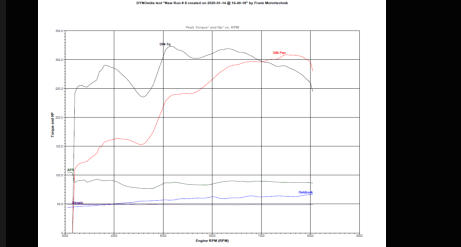



Opel CiH
2,0L
here you can get a competitive engine for a reasonable budget, very
universal for use in Slalom/Rallye/Vintage events. With the stock cast iron
exhaust manifold around 195 HP are possible. A nice torque curve
provides good drivabilty, it could be even used in a daily driver.
2-valve Topversions are around 230 HP/225 NM, reving 9000 rpm and
still provide good torque from the middle, useful for all kind of compitition.
However, the additional effort in preparation and building is significant.
Heavily modfied valve train with my own canshaft, valves, lifters and
rockers. Custom pistons, lubrication system, oil pan, header and fuel
injection among others.
All engines are always “under development” and more power will be found
in small steps.
2,4/2,5 L
Entry level engines are at around 225 HP with 45 DCOE. Building real
2,4L makes no sense any more, There are good forged pistons available
for 2,5 L, and they are even cheaper.
Like the 2,0 L version, there is no limit in effort. The latest Development
for a street driven engine came out with 255 HP plus and 280 Nm.
The usable power band reaches up to 8300 rpm, while still standing wide
open from down low at 2500 rpm.
(see diagram on the left).The torque curve leaves room for improvement.
The given exhaust manifold wasn‘t best suited for it.
Another diagram is also showing a 2,5/8V (a true 2,5) competition engine,
pulling around 270 HP. Still with „off the shelve“ camshaft and exhaust
manifold. With my own camshaft and a dedicated exhaust manifold, I
should see around 280 HP.
All this data is based on (quite reasoanble) specific numbers of ca 12,5
bar mean effectice pressure resulting in 110-114Nm per litre.
There ar numbers around in the net about CiH engines reaching almost
15 bar, quite unreal for such a 2valve engine......
Advertised torque and power figures have to be considere faked
accordingly.
4 Valve
Here are the most fairy tales around......
Building a “cut” 24V, having 250 HP, reving 8000, is fairly easy with
common parts available.
Building a 2,0 16V engine, which is able to stand 10000 rpm repeatedly
and putting out around 300HP plus is another story. There is a lot of
experience in these engines and even more “learn the hard way”.
Therefore, detailed information is rare.
Parts for those engines are not available in online shops and information
on them is not available in forums. I have a few 2,0 and 2,5 engines
running where I cut my teeth.


2,5L 8V street engine, with ITB‘s

2,5 8V competition, almost as many modicications as
the strongest 2,0L. And… it‘s still a real 2,5L

2,0 16V, based on cut 24V, all mods, including
8 injectors, airbox and tuned header

2,0 CiH 8V, competition, no compromise build,
copper beryllium seats and titanium valves
included

2,5L street engine, based on cut 24V head. Short
duration cams, but effetive port modifactions.
Unfortunately, the given exhaust manifold, found cheap
in some online shop by the customer is upsetting the
curves. Nevertheless torque figures are impressive….












